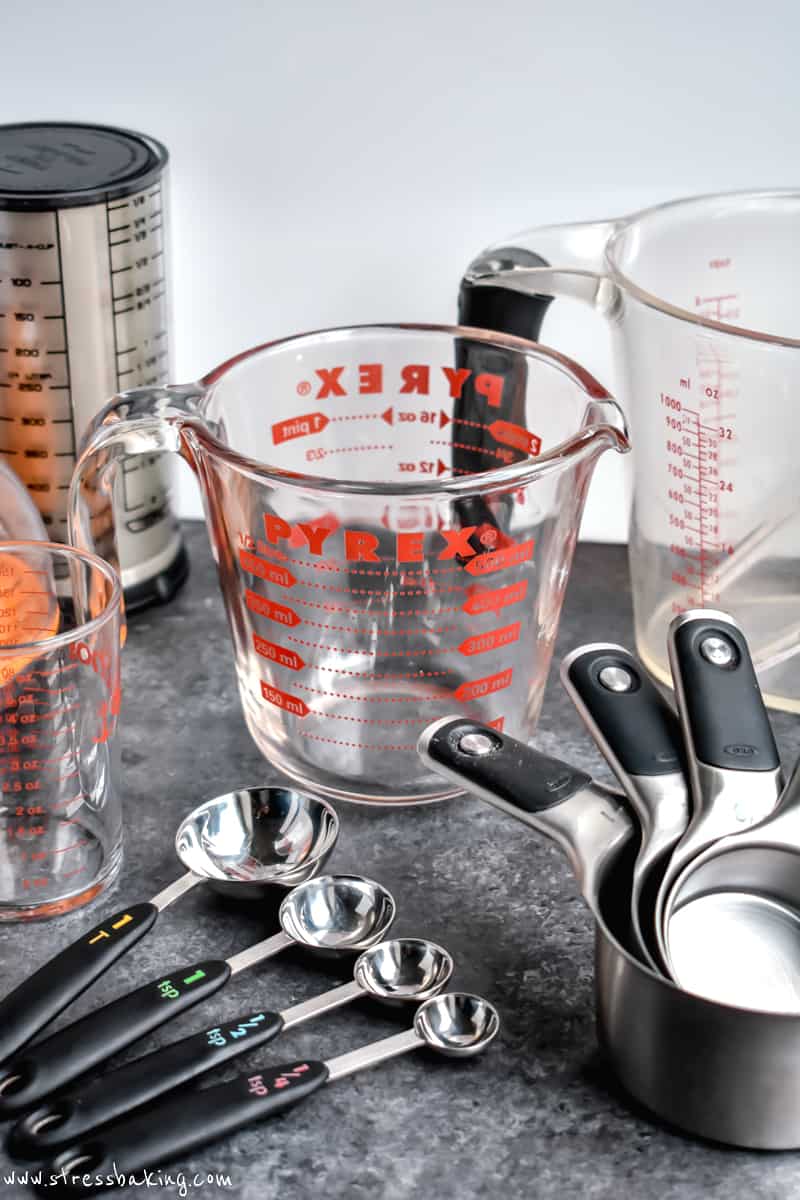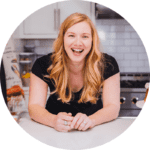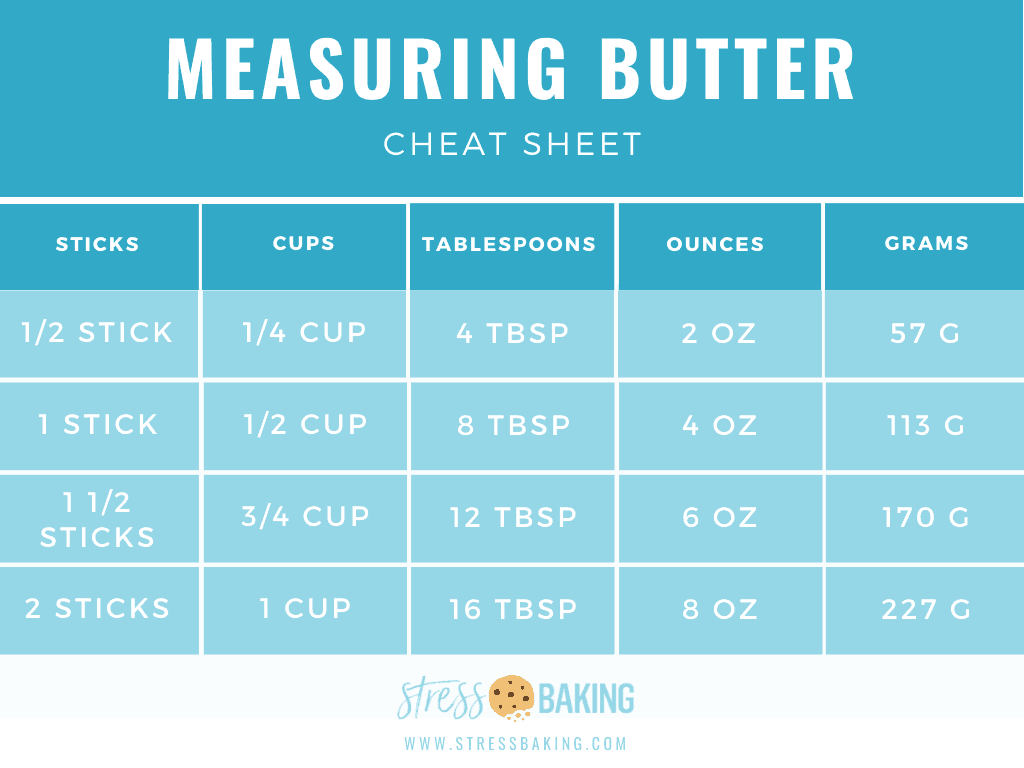Volume Conversions for Baking Recipe Ingredients
Part of my Baking Basics series: These handy conversion charts will help you bake with ease, no matter which units of measurement you use. Includes the most common dry and liquid volume conversions, and tips for measuring different kinds of ingredients.

One of the most frequent questions I receive is about converting recipe ingredients to different units of measurement. Since I live in the United States of America and the majority of my readers are here as well, I opt to write my recipes in U.S. customary units:
- teaspoons
- tablespoons
- ounces
- cups
- pints
- quart
- pounds
- gallons
Mind you, those last two don't come up very often around this site! Could you imagine if they did? I'd be over here telling you to grab 6 gallons of milk and 14 pounds of butter to make frosting … yikes. This isn't the Costco of food blogs.
Aaaaaanyway, I know this must be frustrating to non-U.S. readers, since almost every other country in the world uses the metric system (and I wish I could tell you why the U.S. hasn't gotten on board – let's chalk it up to… we're busy, or something).
I would like to go back to each recipe and add the equivalent measurements in metric units, but that's going to take quite some time – so in the meantime, I'd like to at least provide you with some charts with common metric conversions to help my non-U.S readers.
But first, let's run through the various unit abbreviations you might see to make sure that's all clear:
Common volume unit abbreviations
| Unit | Abbreviation |
| teaspoon | t, tsp |
| Tablespoon | T, Tbsp |
| ounce | oz |
| cup | C, c |
| pint | pt |
| quart | qt |
| pound | lb |
| gallon | gal |
| milliliters | mL, ml |
| liter | L |
| killigrams | kg |
| grams | gm, g |
US to Metric liquid volume conversions
The formula per tablespoon is 1 Tablespoon x 14.787 to get the measurement in milliliters, or 1 Cup x 240.
| U.S. Units | Metric (mL, L) |
| 1 teaspoon | 4.93 milliliters (commonly rounded to 5 mL) |
| 1 Tablespoon | 14.79 milliliters (commonly rounded to 15 mL) |
| 1 ounce | 29.57 milliliters |
| 1 cup | 240 milliliters |
| 1 pint | 473.176 milliliters (commonly rounded to 473) |
| 1 quart | 0.95 liters |
| 1 gallon | 3.79 liters |
US to Metric dry volume conversions
The formula per cup is 1 Cup x 240 to get the measurement in milliliters, and 1 Cup x 4.167 to get the measurement in liters.
| U.S. Units | Metric Units (mL, L) |
| 1 cup | 240 milliliters |
| 1 pint | 550.61 milliliters (commonly rounded to 551), 0.6 L |
| 1 quart | 1.10 liters |
| 1 gallon | 4.40 liters |
Common baking conversions chart
Keep in mind, the measurement of milliliters is rounded for easy reading. For a more precise conversion, the formula per tablespoon is 1 Tablespoon x 14.787 to get the measurement in milliliters:
Measuring butter (butter conversion chart)
Butter can be tricky when you're reading recipes that call for 1 stick and 1/2 cup of butter interchangeably. Here's a cheat sheet for butter conversions to make it a bit easier:
Converting from cups to grams and ounces
This is where things get really tricky. Each type of ingredient will have a different weight, therefore resulting in a different cups > grams > ounces conversion.
The exceptions to the rule are water, milk, and butter – they weigh the same (1 cup = 8 ounces).
Here are some quick, high-level conversions for various types of ingredients to show you what I mean:
| 1 Cup of Ingredient | Weight in Grams | Weight in Ounces |
| Butter | 227 grams | 8 ounces |
| Chocolate chips | 170 grams | 6 ounces |
| Flour, all purpose | 120 grams | 4.25 ounces |
| Flour, whole wheat | 113 grams | 4 ounces |
| Honey | 252 grams | 12 ounces |
| Maple syrup | 312 grams | 11 ounces |
| Milk | 227 grams | 8 ounces |
| Oats | 99 grams | 3.5 ounces |
| Oil, coconut | 226 grams | 6 ounces |
| Oil, vegetable | 198 grams | 7 ounces |
| Peanut butter | 270 grams | 9.5 ounces |
| Sugar, granulated | 198 grams | 7 ounces |
| Sugar, packed brown | 213 grams | 7.5 ounces |
| Sugar, powdered | 114 grams | 4 ounces |
| Water | 227 grams | 8 ounces |
| Yogurt | 242 grams | 8.5 ounces |
Doesn't that feel like complete insanity? I mean, I guess not – it makes sense when you stop to think about it. These items all have different densities, therefore they have different weights.
But that certainly makes it difficult to do a quick conversion of cups to grams or ounces, doesn't it?
You can certainly get into weighing your ingredients if you'd like to, as it is undoubtedly the most accurate way to go about things… but unless noted otherwise in my recipes, I try to keep things as easy as possible and stick to cups.
I want my recipes to be accessible to people in all ranges of baking expertise, and I want you to have a little wiggle room to accommodate variants in your environment (oven calibration, elevation, climate, etc.), and I don't expect everyone to own a kitchen scale – but if a particular recipe calls for it, I will make sure to call that out.
Product Recommendations

I hope this information helps!
Do you have any questions about this topic that I didn't answer? Let me know in the comments below!





I have an emulsion, measurement says add .1% to recipe. I added 1 drop to 11 ounces of water, which was so strong, that I am unable to decipher how to convert. I’m not a math wiz, but it seems like .1% is 1 drop to 5,500 ounces, USA (aka Imperial?) measurement? Thank you so much, these emulsions will go to waste otherwise. I will not purchase from this store – Natures Flavors – again, since they will not provide the answer, & did not fill my order for months, until I got my credit card involved, lol. Thank you! Carol
I’m sorry, Carol – I’m not familiar with that brand so I don’t think I can help. But I agree with you – that’s an odd way to instruct people to use it!
Good morning ma. I just saw your complaint. I want to try to be of assistance to you. We are not all perfect but we can always try and try again so don’t give up on the product just yet even if it means doing countless of trials just to get the perfect and accurate recipe for you. First of all I will love to get some informations from you
1. What recipe are you making
2. I would love to know the quantity of flour in grams if possible used in your recipe
3. Then lastly I don’t know if you have a digital scale that can take readings of minimum 1g. Let’s see if the scale would be sensitive to take readings of a drop of emulsion.
Thanks
Heya i’m for the first time here. I found this board and I find It truly useful & it helped me out much. I hope to give something back and help others like you helped me.